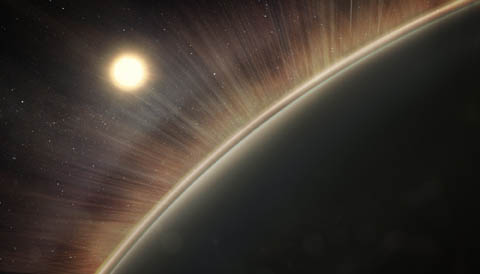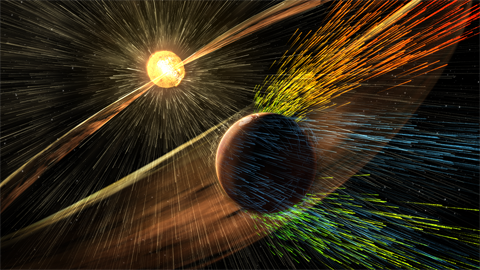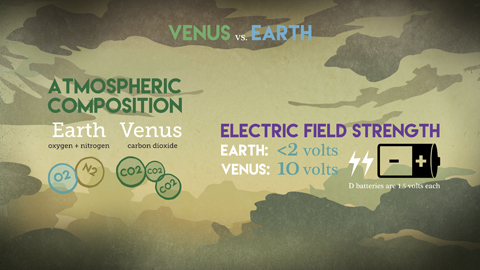The Electric Wind of Venus
June 29, 2016
How close is a planet to a star? Is it rocky or made of gas? Is there water? What is the atmosphere like? There are many factors that play into whether life as we know it can exist on a planet. Through a recent discovery on Venus, scientists may have just found another one.
The atmosphere of a planet can dramatically affect its ability to support life. Among other things, this layer of gas surrounding a planet can help regulate its temperature, protect its surface from harmful radiation, lessen the destruction caused by comets and asteroids, and enable important chemical reactions like those that sustain life here on Earth.
By studying the atmospheres of planets in our solar system, like Venus and Mars, we can better understand what atmospheres do and how they evolve over time. This can help us understand our own atmosphere better, and also teach us what to look for in planets outside of our own solar system.
In a surprising discovery, scientists recently announced that there is an aggressive “electric wind” in the upper atmosphere of Venus. This could be the main reason that Venus doesn’t have any water today, even though scientists think that it once had enough water to fill several oceans.

This is an artist's concept of the electric wind at Venus. The rays extending from the planet's surface represent the paths that oxygen and hydrogen ions take as they are pulled out of the upper atmosphere.
Image Credits: NASA/Goddard/Conceptual Image Lab, Krystofer Kim.
The "Electric Wind"
Venus is a lot like the Earth in several ways—size, gravity, mass, composition, and the presence of an atmosphere and weather systems. There are some important differences, of course, like temperature: the average temperature on the surface of the Earth is about 60°F, while on Venus it’s closer to a toasty 860°F. This is hot enough that any water on Venus would have boiled off as steam ages ago. However, when scientists look at the upper atmosphere of Venus, where the hydrogen and oxygen that made up the H2O should still be, it’s not all there.
Until now, this was often blamed on solar wind. Solar wind is a continuous stream of gas that starts on the sun and gusts through space at about one million miles per hour. When solar wind hits the atmosphere of a planet it can strip away gases trapped there. Another hypothesis is that the hydrogen escaped from the atmosphere and most of the oxygen reacted with rocks on the surface of Venus over billions of years, with the rest being lost to solar wind.

This is an artist's rendering of a solar storm hitting Mars and stripping ions from the planet's upper atmosphere. NASA has released a nice video of this process.
Image Credits: NASA/GSFC
Although the solar wind and oxidation of rocks may be part of the answer, new results from the European Space Agency's Venus Express mission and NASA researchers suggest that the missing water is the result of another force at work.
Imagine an ocean on Venus. The temperature is so hot that the water boils and steam rises. When the water molecules in the steam reach the upper atmosphere, the energy from the sun is so strong that it breaks apart them apart. Where you once had water, you now have negatively charged electrons, positively charged hydrogen ions (ions are atoms with mismatched numbers of protons and electrons), and positively charged oxygen ions.
These electrons and ions join many others in this layer of Venus’ atmosphere, which is similar to the Earth’s ionosphere. All of the positive and negative charges here interact, creating an electric force that surrounds Venus. This force acts like a strong wind, accelerating the positively charged ions to high speeds. The wind has the opposite effect on negative charges like electrons, and slows them down.
Measuring the Wind
The discovery of this electric wind, published last week in the journal Geophysical Research Letters, was made by NASA-funded scientists using data from a spacecraft that observed the atmosphere of Venus for more than eight years. The Venus Express launched near the end of 2005 and concluded its mission in December of 2014.
A key moment came when an instrument onboard the Venus Express called an electron spectrometer (built by the Southwest Research Institute and led by University College London) found that the electrons escaping from the upper atmosphere of Venus were traveling more slowly than expected. Scientists determined that Venus’ electric field was to blame, and calculated its strength based on the speed of the electrons. It turns out to be much stronger than anyone expected—at least five times as powerful as the one on Earth!

After making this discovery, the scientists went through two years of previous data to check for supporting evidence, and they found it. In the journal article, they say that the strong electric wind is a persistent, stable, and global phenomenon on Venus.
This isn’t just an interesting discovery; it has real impact on how Venus evolved.
Things in the atmosphere, like things on the surface of the planet, are held down by gravity. In order to escape into space, an object needs to be going fast enough to overcome the pull of gravity—think of a space shuttle blasting off from the Earth. The speed it needs for an escape depends on its mass and the strength of the gravitational pull it feels. It’s easier for lighter things to escape.
The most surprising thing about this discovery is that the electric wind is strong enough to accelerate even the oxygen—which is HEAVY compared to the electrons and hydrogen—to speeds high enough to escape Venus’ atmosphere. This means that the electric wind could be singlehandedly responsible for Venus’ missing water: the water would be gone even if the solar wind wasn’t around.
Implications
With this discovery, we now know that electric wind can play a very important role in how hydrogen, oxygen, and other ions—including heavy ones—can escape from planetary atmospheres. As we search for planets that might support life, we need to keep this in mind. Understanding the electric wind can help us better predict where we might find habitable planets, and when to discard planets that might otherwise look like promising candidates for supporting life.
In addition, the discovery brings up some great questions about our own atmosphere. What affect does the electric wind on Earth have on how ions escape from our atmosphere? Why is the electric field so much stronger on Venus than the Earth? Is it primarily due to the distance from the sun, or is something else at work?
For a great video highlighting this research, check out NASA's Electric Winds of Venus, below.
—Kendra Redmond














